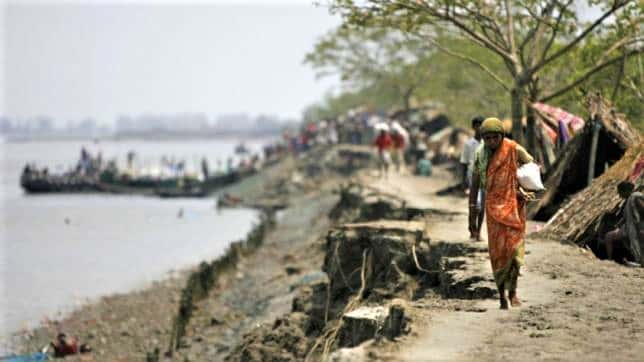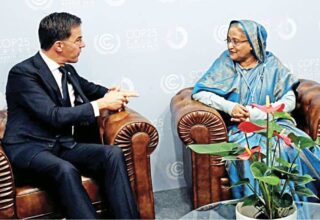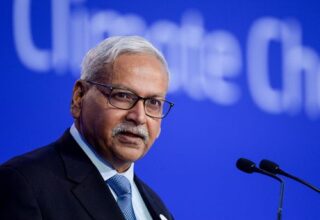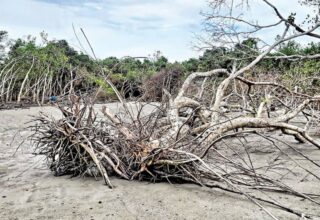
Bangladesh is facing two global megatrends with significant national repercussions. The first is the rapidly urbanising world we live in, where half the global population is already living in cities and towns and Bangladesh will soon cross that threshold as well. The government of Bangladesh under the direction of the prime minister has taken up the policy to enable every village to avail the services of a town so that people no longer feel that they have to move.
Laudable as this policy is, at best it will delay and decrease the rate of urbanisation in Bangladesh so we have to be better prepared with what kind of urbanisation we want to encourage and plan for.
At the moment a very large proportion of the rural to urban migration is coming to Dhaka which has become the fastest growing mega city in the world. There is hence a dire need to redirect this movement to other cities and towns.
This megatrend of urbanisation has also affected the second megatrend of climate change which is likely to cause significant adverse effects on Bangladesh, with particularly severe impacts on the low lying coastal areas of the country as it will mean significant numbers (possibly around ten million over the next two decades) of climate migrants moving from rural to urban areas.
The latest climate change scenarios with regard to potential sea level rise have enhanced the calculations of sea level rise to double, and in some case even triple, the earlier IPCC scenarios. This is quite alarming for the people living in the low lying coastal areas of Bangladesh.
The answer to this second megatrend of climate change impacts on coastal areas must rely on a twin track strategy with two distinct time lines and target populations. The first time line is the “short to medium term” and the target population are the adults living in the climate affected areas; to help them to adapt to the changing scenarios. This is now already happening at scale with provision of rainwater harvesting for drinking water and saline tolerant crops in the coastal areas.
The second timeline and target population are the adults of tomorrow, namely young girls and boys of today, who should be given education and skills training to enable them to not have to become fishers and farmers like their parents, but be able to get better paying jobs in towns and cities.
There is an extra dimension to the interaction of these two megatrends in Bangladesh in that the accelerated rural to urban migration, if left to happen on its own, is likely to make Dhaka even bigger and perhaps take it beyond its carrying capacity.
Hence we need to try to ensure that potential migrants choose to go elsewhere rather than come to Dhaka. As we cannot force anyone to not come to Dhaka we need to create incentives for them to go to other towns.
This entails investing in other towns to make them both climate resilient and migrant friendly over time.
In climate change jargon, helping the population to cope with ongoing climate change impacts is known as incremental adaptation; whereas educating and enabling the children to move to better paying jobs in towns would be transformational adaptation to climate change, as they would no longer be facing the same problems and would be economically better off as well.
The International Centre for Climate Change and Development (ICCCAD) together with a number of partner organisations working on urban issues in Bangladesh has held annual conferences on Urban Resilience for the last four years where the concept of climate resilient migrant friendly towns was first introduced last year. Since then a number of mayors of smaller towns, starting with Mongla have already embarked on trying to explore and embrace the concept. This is not a government or even NGO project or programme; rather a concept that anyone, including individual citizens, can embrace and explore.
The fourth annual Urban Resilience Conference was held in Dhaka last week where over twenty mayors of Pourashavas have expressed keen interest in exploring the concept n their own towns. This will entail examining the job creation opportunity in each town based on its geography and proximity to one of the hundred economic zones that the government is planning to set up (as jobs are still the major magnet for migrants). It also entails looking at opportunities to enhance education at high school and college and vocational level in order to attract young girls and boys from the coastal zone to come and study (and potentially settle) in those towns; perhaps by offering scholarships for them.
At a macro level, the idea is to identify around twenty towns which can attract and help settle around half a million migrants, each over the next ten to twenty years to ensure that ten million potential climate migrants do not end up in Dhaka city over that time.
It is indeed a great challenge which will require not just new kinds of urban planning, but also redistribution of private sector investment towards these smaller towns.
The two megatrends of urbanisation and climate change are being perceived as big problems both globally and nationally. But we have the opportunity in Bangladesh to be proactive in anticipating possible solutions to the two megatrends and finding ways to minimise their negative aspects and maximise the positive opportunities that they present.
Originally this article was published on October 30, 2019 at Daily Star. The author Dr. Saleemul Huq is the director of the International Centre for Climate Change and Development (ICCCAD) at the Independent University, Bangladesh (IUB).
Email: saleemul.huq@icccad.net






